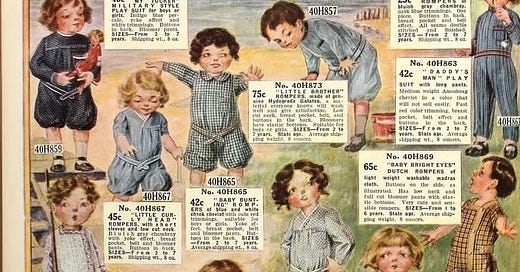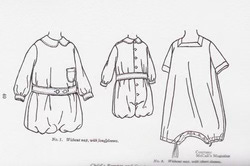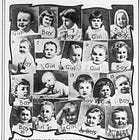Creepers and Rompers: the Quiet Revolution
How little girls got to wear pants, some with pockets!
Ever hear of Amelia Bloomer? She was the American writer and activist who attempted to reform women's fashions in the 1850s by advocating -- and wearing -- knee-length dresses with full matching trousers underneath. She and other dress reformers called it "the American costume", to differentiate it from French-influences fashions, but the popular name "bloomers" stuck. The idea of women wearing any form of trousers was ridiculed and roundly rejected, but bloomers became acceptable for athletic costume, as long as they were not worn in public.
Fast forward to the 1890s, when bicycles were the latest craze, and young women traded flowing dresses for divided skirts, bloomers and even their brothers' knickers in order to enjoy the new pastime. Once again, the cartoonists and editorial writers had a field day, but this time practicality won out.
At the same time, a quiet revolution was taking place in children's clothing. Some unknown enterprising person -- probably a mother -- had the brilliant idea of sewing up the hem of her baby's dress, leaving only two holes for the legs. The resulting "creeping apron" (later shortened to "creeper") was initially worn over another dress, like a pinafore, but by the 1910s was worn by itself.
A more fitted version, the romper, was introduced for toddlers. Physicians and advice manual writers praised these outfits as being ideal for both boys and girls.
In contrast to the reception of trousers for women, the idea of putting little girls in creepers and rompers met with apparently universal approval. There were no anti-romper cartoons, no editorials decrying the masculinization of girls. According to the baby books and paper dolls I have seen, rompers replaced white dresses as the preferred neutral option for toddlers very swiftly, between 1910 and 1920. I say "neutral" because until the 1930s, gender-specific version of either garments were very rare. (Yes, boys wore pink rompers. Pink and blue were decades away from being universally gendered colors. If you missed that post, here it is.)
Notice all the rompers described as “for boys or girls”. Notice the colors. Notice the pockets! Sears, 1916.








Wonderful piece, Jo. The rompers remind me of the blue gym suits we wore in school when I was growing up.